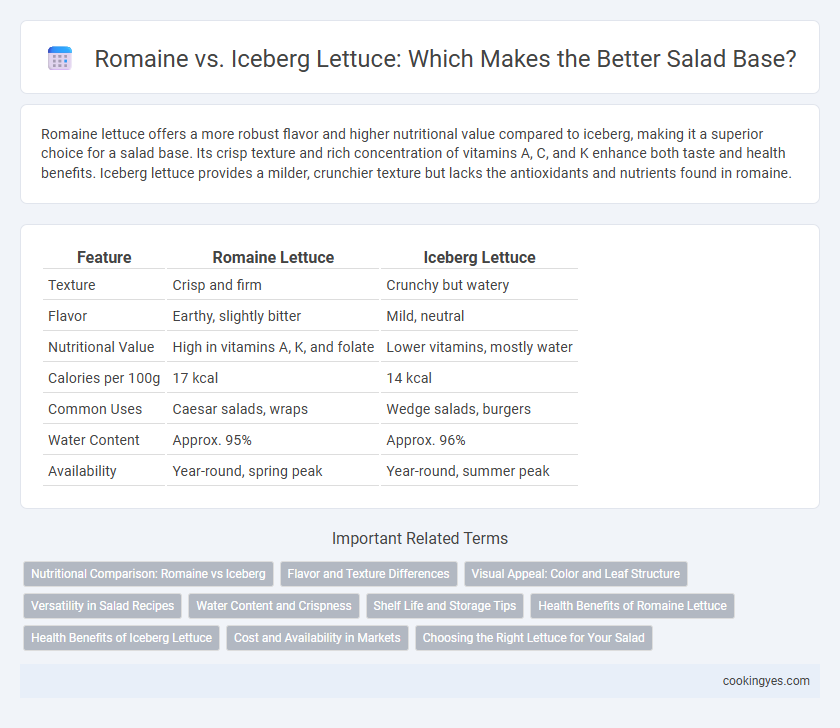Romaine lettuce offers a more robust flavor and higher nutritional value compared to iceberg, making it a superior choice for a salad base. Its crisp texture and rich concentration of vitamins A, C, and K enhance both taste and health benefits. Iceberg lettuce provides a milder, crunchier texture but lacks the antioxidants and nutrients found in romaine.
Table of Comparison
| Feature | Romaine Lettuce | Iceberg Lettuce |
|---|---|---|
| Texture | Crisp and firm | Crunchy but watery |
| Flavor | Earthy, slightly bitter | Mild, neutral |
| Nutritional Value | High in vitamins A, K, and folate | Lower vitamins, mostly water |
| Calories per 100g | 17 kcal | 14 kcal |
| Common Uses | Caesar salads, wraps | Wedge salads, burgers |
| Water Content | Approx. 95% | Approx. 96% |
| Availability | Year-round, spring peak | Year-round, summer peak |
Nutritional Comparison: Romaine vs Iceberg
Romaine lettuce offers significantly higher nutritional value compared to iceberg lettuce, providing more vitamins A, C, and K, as well as folate and fiber. Iceberg lettuce contains a higher water content, making it lower in calories but less nutrient-dense. Choosing romaine as a lettuce base enhances the salad's overall health benefits by boosting antioxidant intake and supporting immune function.
Flavor and Texture Differences
Romaine lettuce offers a robust, slightly bitter flavor with a crisp, crunchy texture that holds up well in salads. Iceberg lettuce provides a mild, watery taste and a more delicate, crunchy texture, adding great freshness but less complexity. Choosing between Romaine and Iceberg depends on preference for stronger flavor and hearty crunch versus lighter taste and crispness.
Visual Appeal: Color and Leaf Structure
Romaine lettuce features long, dark green leaves with a sturdy rib, providing a rich, vibrant color and a crisp texture that enhances the salad's visual appeal. Iceberg lettuce displays pale green, tightly packed, round leaves offering a light, refreshing look but less color intensity compared to Romaine. The robust leaf structure of Romaine creates a dynamic visual contrast in salads, while Iceberg's uniform shape contributes to a clean and simple presentation.
Versatility in Salad Recipes
Romaine lettuce offers superior versatility in salad recipes due to its crisp texture and slightly bitter flavor, which complements a wide range of dressings and ingredients. Iceberg lettuce provides a mild taste and crunchy texture but tends to lack the nutrient density and bold flavor that enhance complex salads. Choosing romaine as a base allows for more diverse and flavorful combinations, making it ideal for chef-inspired and health-conscious salad creations.
Water Content and Crispness
Romaine lettuce contains approximately 95% water, offering a balance of hydration and firm texture, while iceberg lettuce boasts about 96% water content, making it the crispiest and most refreshing lettuce base. Romaine's robust leaves provide a hearty crunch and richer flavor, enhancing salads with its nutrient density, whereas iceberg's higher water content delivers a light, crisp bite ideal for adding volume and crunch without overpowering other ingredients. Choosing between Romaine and iceberg lettuce base depends on desired salad texture and hydration level, with Romaine excelling in crispness and nutrient content, and iceberg offering superior water content for maximum freshness.
Shelf Life and Storage Tips
Romaine lettuce offers a longer shelf life compared to iceberg, typically lasting up to 10 days when stored properly in a crisp, cool environment. Iceberg lettuce, known for its dense layers and high water content, stays fresh for about 7 to 10 days when refrigerated in a perforated plastic bag to maintain moisture. For optimal storage, both varieties benefit from keeping the leaves dry and avoiding airtight containers to prevent wilting and bacterial growth.
Health Benefits of Romaine Lettuce
Romaine lettuce offers superior health benefits compared to iceberg due to its higher vitamin and mineral content, including vitamins A, K, and C, as well as folate and fiber. Its dense nutrient profile supports immune function, bone health, and digestion more effectively than the water-rich, lower-calorie iceberg variety. Choosing romaine as a salad base enhances nutritional value and promotes long-term wellness.
Health Benefits of Iceberg Lettuce
Iceberg lettuce is particularly valued for its high water content, making it an excellent choice for hydration and low-calorie diets. It provides essential nutrients such as vitamin K, which supports bone health, and small amounts of fiber that aid digestion. Compared to romaine, iceberg lettuce offers a milder taste and crisp texture while contributing to a refreshing salad base with fewer calories.
Cost and Availability in Markets
Romaine lettuce generally costs more than iceberg due to its higher nutrient density and freshness demand, yet both are widely available in most supermarkets year-round. Iceberg lettuce benefits from lower prices and greater shelf stability, making it a preferred choice for budget-conscious consumers and high-volume salad production. Market availability favors iceberg in bulk quantities, while romaine is often sold in smaller packages or pre-washed bags targeting premium and health-focused shoppers.
Choosing the Right Lettuce for Your Salad
Romaine lettuce offers a nutrient-rich base with high levels of vitamin A, vitamin K, and folate, making it ideal for health-conscious salads. Iceberg lettuce provides a crisp texture and mild flavor with higher water content, perfect for adding crunch without overwhelming other ingredients. Selecting between Romaine and Iceberg depends on whether you prioritize nutritional value or texture in your salad base.
Romaine vs Iceberg for Lettuce Base Infographic

 cookingyes.com
cookingyes.com